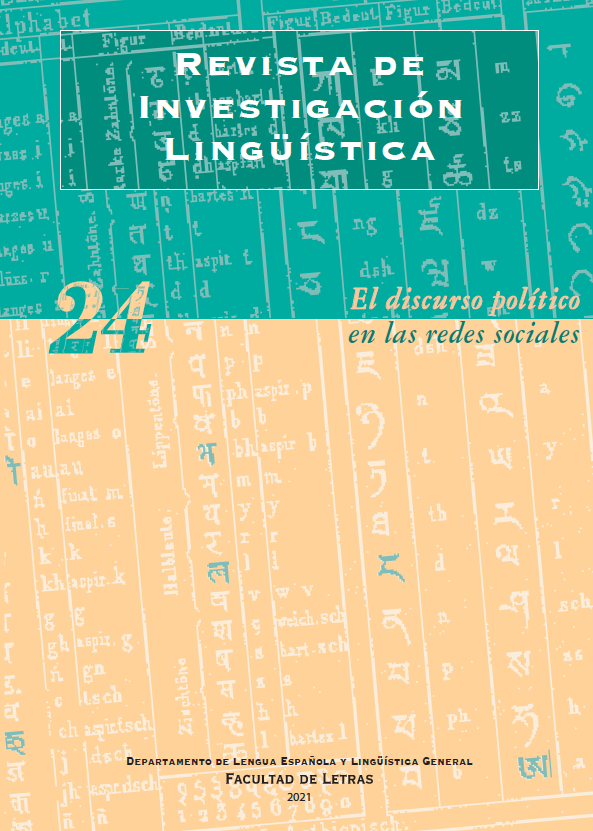María Martínez-Atienza de Dios (2021): «Entre el léxico y la sintaxis: las fases de los eventos», Berna, Peter Lang, 142 pp.
Descargas
-
Resumen371
-
PDF542
Citas
CARTAGENA, Nelson (1978): «Acerca de las categorías de tiempo y aspecto en el sistema verbal del español», Revista Española de Lingüística, 8(2), pp. 373-408.
COSERIU, Eugenio (1976): Das romanische Verbalsystem, Tübingen, Gunter Narr.
DE MIGUEL, Elena (1999): «El aspecto léxico», en Violeta Demonte e Ignacio Bosque (coords.), Gramática descriptiva de la lengua española (2). Las construcciones sintácticas fundamentales. Relaciones temporales, aspectuales y modales, Madrid, Espasa, pp. 2977-3060.
DIETRICH, Wolf (1983): El aspecto verbal perifrástico en las lenguas románicas, Madrid, Gredos.
FERNÁNDEZ DE CASTRO, Félix (1999): Las perífrasis verbales en el español actual, Madrid, Gredos.
GARACHANA CAMARERO, Mar (2016): «Restricciones léxicas en la gramaticalización de las perífrasis verbales», Rilce, 32(1), pp. 134-158.
GARCÍA FERNÁNDEZ, Luis (dir.), Ángeles Carrasco Gutiérrez, Bruno Camus Bergareche, María Martínez-Atienza y María Ángeles García García-Serrano (2006): Diccionario de perífrasis verbales, Madrid, Gredos.
GARCÍA FERNÁNDEZ, Luis y Ángeles CARRASCO GUTIÉRREZ (2008): «Perífrasis verbales con función de marcador del discurso, contrarréplica a Olbertz (2007)», Verba. Anuario Galego de Filoloxía, 35, pp. 439-447.
GÓMEZ TORREGO, Leonardo (1988): Perífrasis verbales. Sintaxis, semántica y estilística, Madrid, Arco/Libros.
GÓMEZ TORREGO, Leonardo (1999): «Los verbos auxiliares. Las perífrasis verbales de infinitivo», en Violeta Demonte e Ignacio Bosque (coords.), Gramática descriptiva de la lengua española (2). Las construcciones sintácticas fundamentales. Relaciones temporales, aspectuales y modales, Madrid, Espasa, pp. 3323-3389.
MARTÍNEZ-ATIENZA, María (2017): «Confusiones frecuentes relativas al aspecto gramatical y al aspecto léxico», Revista de Investigación Lingüística, 20, 179-193.
OLBERTZ, HELLA (2007): «¿Perífrasis verbales con función de marcador de discurso?: a propósito del Diccionario de perífrasis verbales», Verba. Anuario Galego de Filoloxía, 34, 381-390.
PENAS IBÁÑEZ, M.ª Azucena y Nelli Minasyan (2020): «La preposición en las perífrasis discursivas del español. Un reto para el armenio», Romanica Olomucensia, 32(2), pp. 243-260. https://doi.org/10.5507/ro.2020.013
ROJO, Guillermo (1974): Perífrasis verbales en el gallego actual, Verba, Anejo 2, Santiago de Compostela, Universidad de Santiago.
ROJO, Guillermo (1990): «Relaciones entre temporalidad y aspecto en el verbo español», en Ignacio Bosque (coord.), Tiempo y aspecto en español, Madrid, Cátedra, pp. 17-44.
VEYRAT RIGAT, Montserrat (1994): «La perífrasis verbal acabar de + infinitivo y la resolución de su ambigüedad», Voz romanica. Annales Helvetici Explorandis Linguis Romanicis Destinati, 53, pp. 238-252.
Derechos de autor 2022 Revista de Investigación Lingüística

Esta obra está bajo una licencia internacional Creative Commons Atribución-NoComercial-SinDerivadas 4.0.
Las obras que se publican en esta revista están sujetas a los siguientes términos:
1. El Servicio de Publicaciones de la Universidad de Murcia (la editorial) conserva los derechos patrimoniales (copyright) de las obras publicadas, y favorece y permite la reutilización de las mismas bajo la licencia de uso indicada en el punto 2.
2. Las obras se publican en la edición electrónica de la revista bajo una licencia Creative Commons Reconocimiento-NoComercial-SinObrasDerivadas 4.0 (texto legal). Se pueden copiar, usar, difundir, transmitir y exponer públicamente, siempre que: i) se cite la autoría y la fuente original de su publicación (revista, editorial y URL de la obra); ii) no se usen para fines comerciales; iii) se mencione la existencia y especificaciones de esta licencia de uso.
3. Condiciones de auto-archivo. Se permite y se anima a los autores a difundir electrónicamente las versiones pre-print (versión antes de ser evaluada) y/o post-print (versión evaluada y aceptada para su publicación) de sus obras antes de su publicación, ya que favorece su circulación y difusión más temprana y con ello un posible aumento en su citación y alcance entre la comunidad académica. Dulcinea: verde. OPF.









